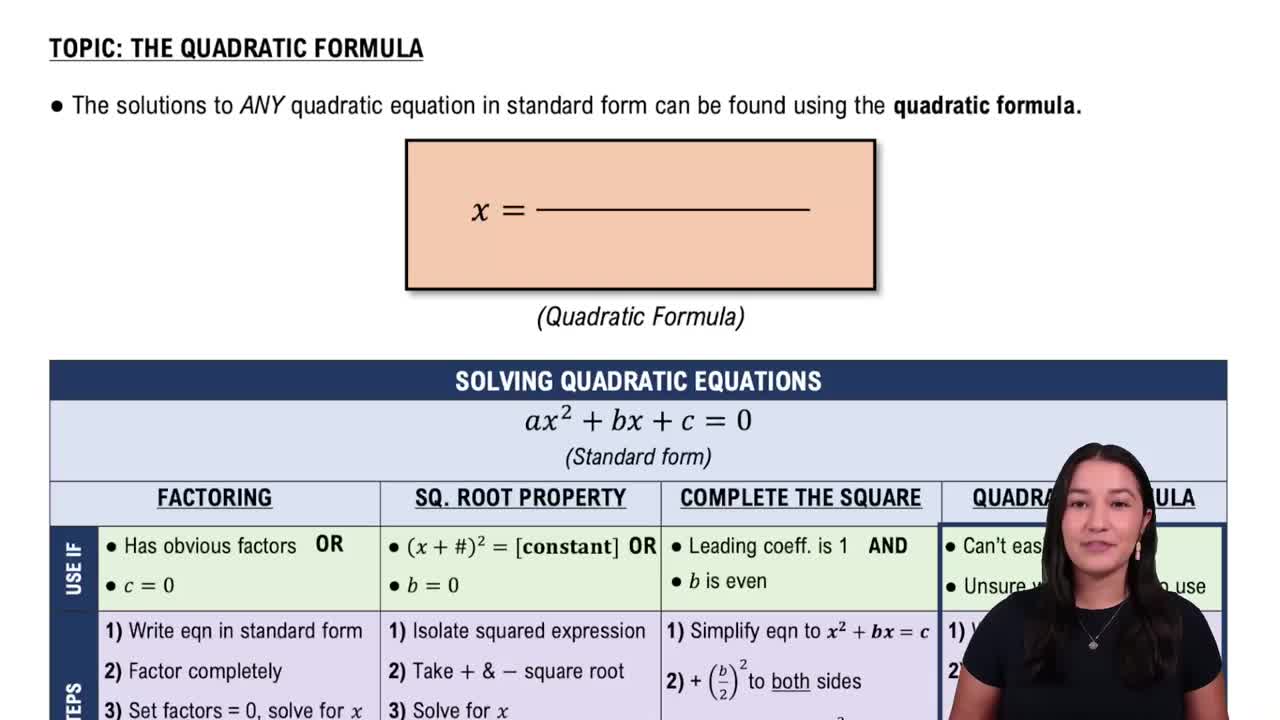Table of contents
- 0. Review of Algebra4h 16m
- 1. Equations & Inequalities3h 18m
- 2. Graphs of Equations43m
- 3. Functions2h 17m
- 4. Polynomial Functions1h 44m
- 5. Rational Functions1h 23m
- 6. Exponential & Logarithmic Functions2h 28m
- 7. Systems of Equations & Matrices4h 6m
- 8. Conic Sections2h 23m
- 9. Sequences, Series, & Induction1h 19m
- 10. Combinatorics & Probability1h 45m
4. Polynomial Functions
Zeros of Polynomial Functions
Problem 82a
Textbook Question
Exercises 82–84 will help you prepare for the material covered in the next section. Solve: x^2+4x−1=0
 Verified step by step guidance
Verified step by step guidance1
Identify the type of equation: This is a quadratic equation in the form \( ax^2 + bx + c = 0 \), where \( a = 1 \), \( b = 4 \), and \( c = -1 \).
Use the quadratic formula to solve for \( x \): \( x = \frac{-b \pm \sqrt{b^2 - 4ac}}{2a} \).
Substitute the values of \( a \), \( b \), and \( c \) into the quadratic formula: \( x = \frac{-4 \pm \sqrt{4^2 - 4 \cdot 1 \cdot (-1)}}{2 \cdot 1} \).
Simplify the expression under the square root (the discriminant): \( 4^2 - 4 \cdot 1 \cdot (-1) \).
Continue simplifying the expression to find the values of \( x \).
Recommended similar problem, with video answer:
 Verified Solution
Verified SolutionThis video solution was recommended by our tutors as helpful for the problem above
Video duration:
2mPlay a video:
Was this helpful?
Key Concepts
Here are the essential concepts you must grasp in order to answer the question correctly.
Quadratic Equations
A quadratic equation is a polynomial equation of the form ax^2 + bx + c = 0, where a, b, and c are constants, and a ≠ 0. These equations can be solved using various methods, including factoring, completing the square, or applying the quadratic formula. Understanding the structure of quadratic equations is essential for identifying their solutions.
Recommended video:

Introduction to Quadratic Equations
Factoring
Factoring involves rewriting an expression as a product of its factors. For quadratic equations, this means expressing the equation in a form that can be easily solved, such as (x + p)(x + q) = 0. This method is particularly useful when the quadratic can be factored into integers, allowing for straightforward identification of the roots.
Recommended video:
Guided course

Factor by Grouping
Quadratic Formula
The quadratic formula, x = (-b ± √(b² - 4ac)) / (2a), provides a systematic way to find the roots of any quadratic equation. It is derived from completing the square and is applicable even when factoring is not feasible. Understanding how to apply this formula is crucial for solving quadratic equations efficiently.
Recommended video:

Solving Quadratic Equations Using The Quadratic Formula
Related Videos
Related Practice


